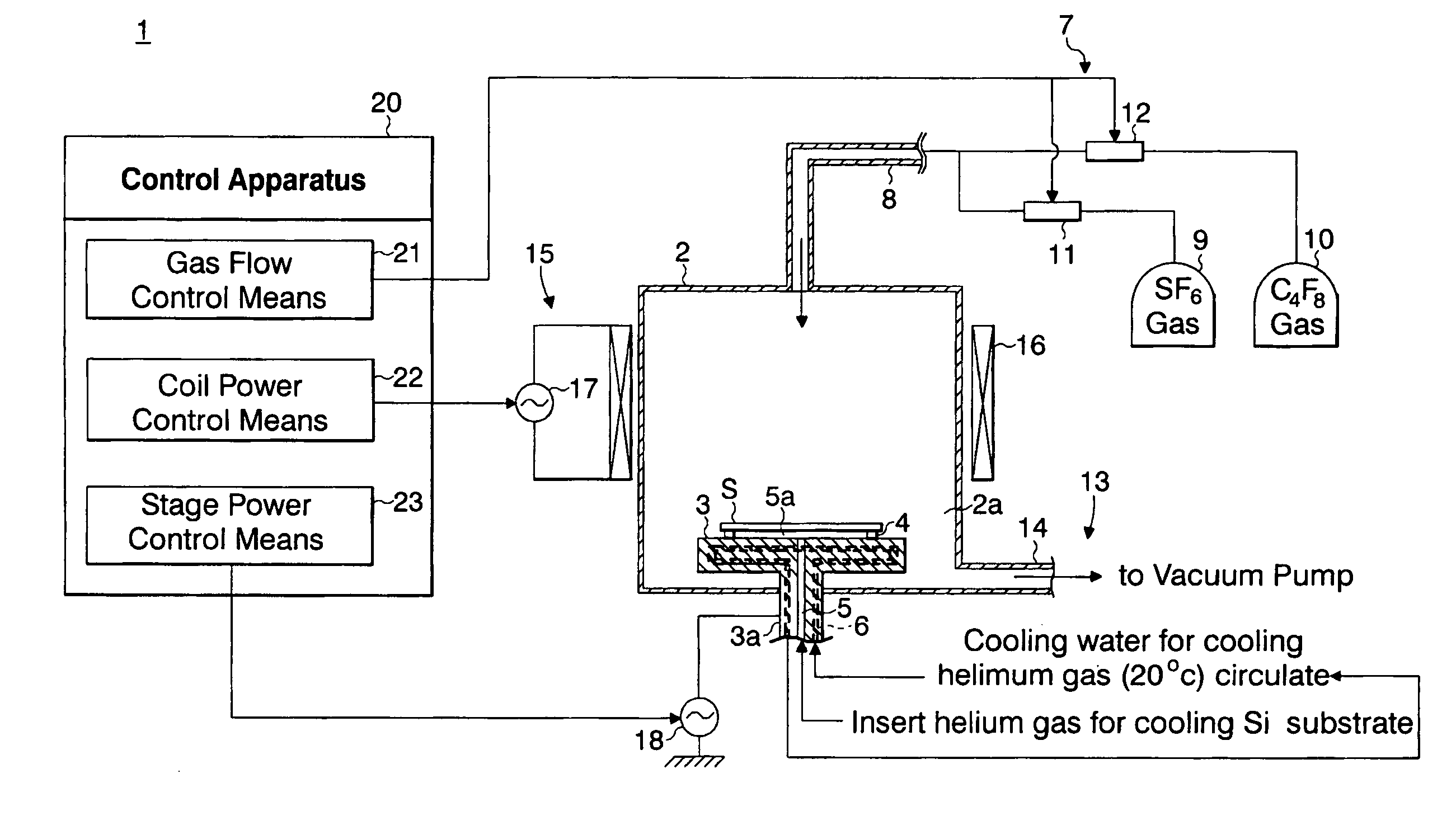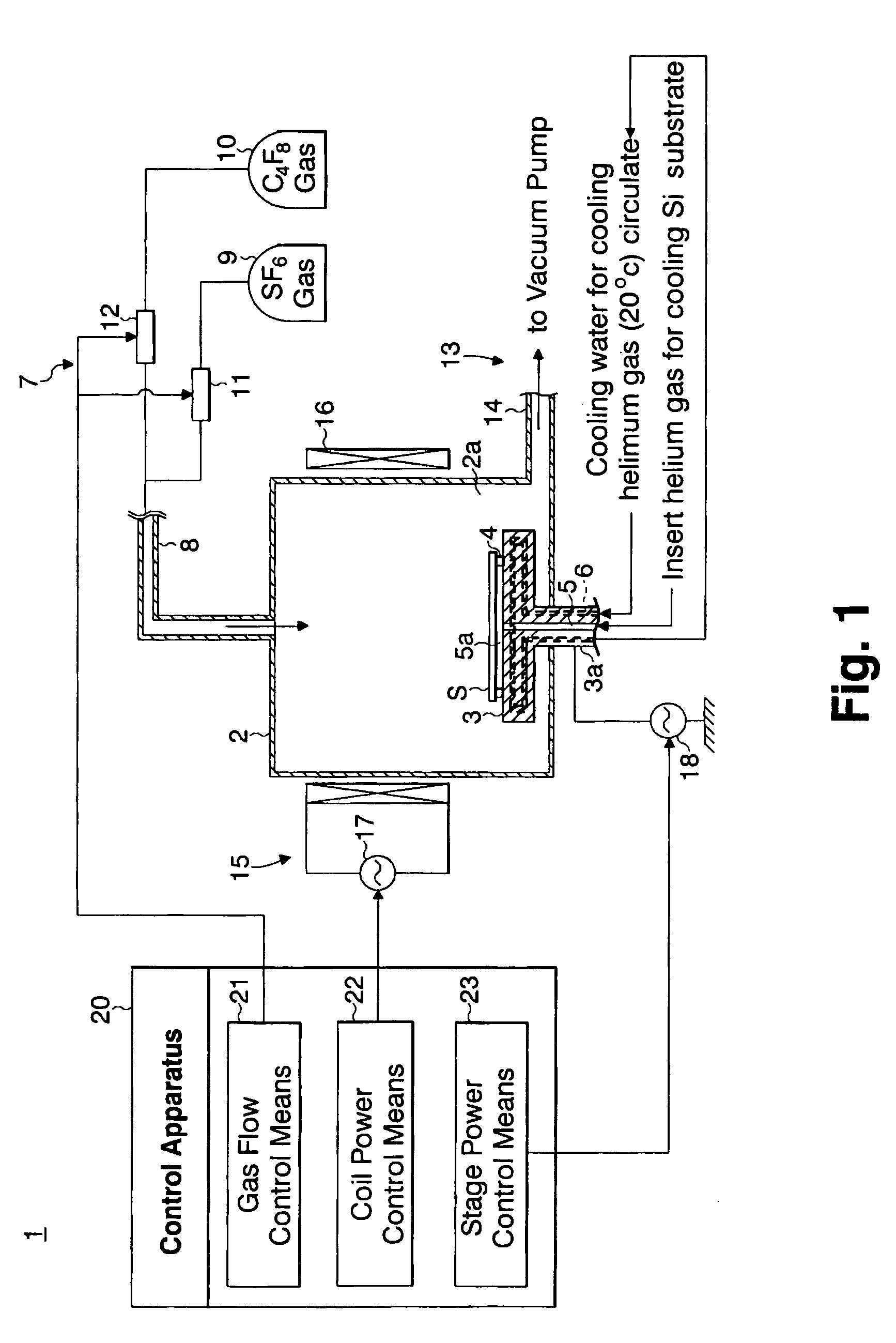Method for etching of a silicon substrate and etching apparatus
a technology of etching apparatus and silicon substrate, which is applied in the direction of electrical apparatus, decorative surface effects, decorative arts, etc., can solve the problems of uneven wall surfaces, poor processing precision, and new wall surfaces formed by etching without protective films, etc., and achieve excellent perpendicularity and sufficient smoothness without reducing etching speed
- Summary
- Abstract
- Description
- Claims
- Application Information
AI Technical Summary
Benefits of technology
Problems solved by technology
Method used
Image
Examples
experiment 1
1. Experiment 1
[0073]For the etching gas, SF6 gas was used, and for the protective film formation gas, C4F8 gas was used. For the high frequency power applied to coil 16, Wo1 was 2200 W, and Wo2 was 1500 W. For the high frequency power applied to stage 3, Wp1 was 40 W, Wp2 was 20 W. Flow rate Ve1 of SF6 gas during step e was 450 ml / min, and flow rate Vd1 of C4F8 gas during step d was 150 ml / min. During step d, flow rate Ve2 for SF6 gas changed to 0 ml / min, 3 ml / min, 4.5 ml / min, 7.5 ml / min, 15 ml / min. Furthermore, during step e, flow rate Vd2 of C4F8 gas changed to 0 ml / min, 22.5 ml / min, 31.5 ml / min, 54 ml / min, 90 ml / min, 135 ml / min. The silicon substrate was etched under these conditions, and a hole 31 as shown in FIG. 3 was formed on the silicon substrate.
[0074]The processing time for step e was 8.5 seconds and the processing time for step d was 3 seconds. Steps e and d were implemented repeatedly for 15 minutes. In addition, the pressure inside etching chamber 2 was 4.0 Pa in step...
experiment 2
2. Experiment 2
[0080]SF6 gas was used again as etching gas, and C4F8 gas was used as protective film formation gas. For the high frequency power applied to coil 16, Wo1 was 900 W and Wo2 was 800 W. For the high frequency power applied to stage 3, Wp1 was 25 W and Wp2 was 5 W. Flow rate Ve1 of SF6 gas during step e was 200 ml / min, and flow rate Vd1 of C4F8 gas during step d was 60 ml / min. During step d, flow rate Ve2 for SF6 gas changed to 0 ml / min, 1.2 ml / min, 1.8 ml / min, 3 ml / min, 6 ml / min. Furthermore, during step e, flow rate Vd2 of C4F8 gas changed to 0 ml / min, 10 ml / min, 14 ml / min, 24 ml / min, 40 ml / min. The silicon substrate was etched under these conditions, and a hole 31 as shown in FIG. 3 was formed on the silicon substrate.
[0081]The processing time for step e was 15 seconds and the processing time for step d was 7 seconds. Steps e and d were implemented repeatedly for 30 minutes. In addition, the pressure inside etching chamber 2 was 2.5 Pa in step e and 0.8 Pa in step d.
[0...
PUM
| Property | Measurement | Unit |
|---|---|---|
| volume ratio | aaaaa | aaaaa |
| volume ratio | aaaaa | aaaaa |
| frequency | aaaaa | aaaaa |
Abstract
Description
Claims
Application Information
 Login to View More
Login to View More - R&D
- Intellectual Property
- Life Sciences
- Materials
- Tech Scout
- Unparalleled Data Quality
- Higher Quality Content
- 60% Fewer Hallucinations
Browse by: Latest US Patents, China's latest patents, Technical Efficacy Thesaurus, Application Domain, Technology Topic, Popular Technical Reports.
© 2025 PatSnap. All rights reserved.Legal|Privacy policy|Modern Slavery Act Transparency Statement|Sitemap|About US| Contact US: help@patsnap.com



